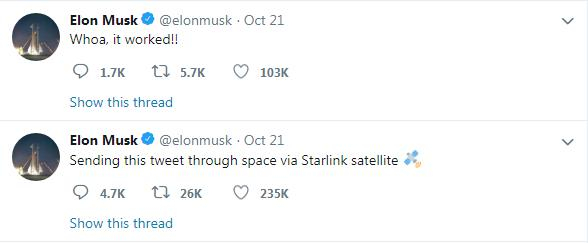The U.S. private space company SpaceX said that its Starlink constellation was expected to start offering broadband service in the United States in the middle of 2020.
It came after SpaceX CEO Elon Musk on Tuesday sent a tweet he claimed via the company's Starlink broadband satellite.
"Sending this tweet through space via Starlink satellite," Musk wrote. Two minutes later, he followed up by "Whoa, it worked!"

SpaceX CEO Elon Musk's tweets. /Twitter Screenshot
SpaceX CEO Elon Musk's tweets. /Twitter Screenshot
SpaceX designed Starlink to connect end users with low-latency and high-bandwidth broadband services by providing continual coverage around the world using a network of thousands of satellites in low Earth orbit.
It launched its first batch of 60 Starlink satellites into space in May. It was only a small part of the constellation which is expected to grow to about 12,000 satellites by 2024, according to Musk.
Last week, SpaceX revealed a bigger internet-from-space ambition. It has filed documents to the International Telecommunication Union for approval of 30,000 additional Starlink satellites, bringing the total to 42,000.
SpaceX president and chief operating officer Gwynne Shotwell said on Tuesday at the ongoing International Astronautical Congress that the company needs six to eight satellite launches to get sufficient coverage to start offering the service to consumers in 2020, which is quite a challenging task.
Also, technically, users cannot directly link their smart devices to the satellites as they have access to WiFi hotspots. They need using a large number of terminals on the ground to transmit broadband signals from the satellites, which SpaceX must develop and build.
The astronomical community has expressed their concern over Musk's internet constellation project, fearing that too many bright artificial satellites will ruin the night sky and affect astronomical observations.
The large group of internet satellites posed challenges to space traffic management as well. In September, a European Earth-observation satellite performed an evasive maneuver to avoid possible collision with one Starlink satellite.
Source(s): Xinhua News Agency